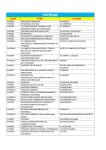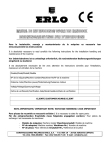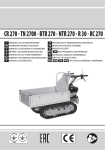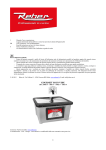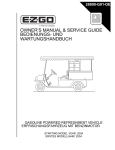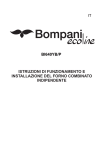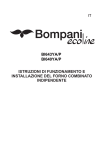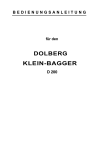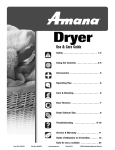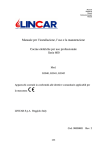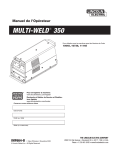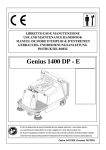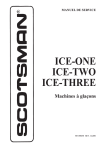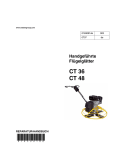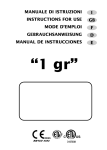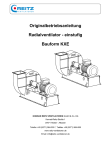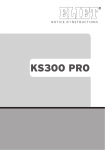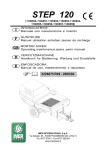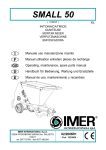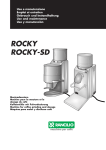Download DELTA "V" 90 - DELTA "V" 120
Transcript
DELTA "V" 90 - DELTA "V" 120 (1193164 - 1193156) LISCIATRICE TRUELLE MECANIQUE SMOOTHING MACHINE GLÄTTEMASCHINE ALISIDORA manuale uso manutenzione ricambi manuel utilisation entretien pieces de rechange Operating,maintenance, spare parts manual Handbuch für Bedienung, Wartung und Ersatzteile manual de uso, mantenimiento y recambios IMER INTERNATIONAL S.p.A. 53036 POGGIBONSI (SIENA) loc. SALCETO (ITALY) tel. (0577) 97341 - fax (0577) 983304 R06 - 2005/03 Cod. 2288975 I IMER INTERNATIONAL S.p.A. DELTA "V" 90 - 120 Fig.1 Caro Cliente, ci complimentiamo per il suo acquisto: la lisciatrice IMER, risultato di anni di esperienza, è una macchina di massima affidabilità e dotata di soluzione tecniche innovative. OPERARE IN SICUREZZA. E’ fondamentale ai fini della sicurezza leggere attentamente le seguenti istruzioni. Il presente manuale di USO E MANUTENZIONE deve essere custodito dal responsabile di cantiere nella persona del CAPOCANTIERE nel cantiere stesso, sempre disponibile per la consultazione. Il manuale è da considerarsi parte della macchina e deve essere conservato per futuri riferimenti (EN 12100/2) fino alla distruzione della macchina stessa. In caso di danneggiamento o smarrimento potrà essere richiesto al costruttore un nuovo esemplare. Il manuale contiene importanti indicazioni sulla preparazione del cantiere, l’installazione, l’uso, le modalità di manutenzione e la richiesta di parti di ricambio. Comunque è da ritenersi indispensabile una adeguata esperienza e conoscenza della macchina da parte del montatore e dell’utilizzatore. Affinchè sia possibile garantire la sicurezza dell’operatore, la sicurezza di funzionamento e una lunga durata della macchina devono essere rispettate le istruzioni del manuale, unitamente alle norme di sicurezza e prevenzione degli infortuni sul lavoro secondo la legislazione vigente (uso di calzature e abbigliamento adeguati, uso di elmetti, guanti ed occhiali sec. D.P.R. 164 e D.P.R. 547. 1 MANUBRIO DI COMANDO 2 LEVA ACCELERATORE/SPEGNIMENTO 3 LEVA COMANDO SOLLEVAMENTO PALE 4 POMELLO REGOLAZIONE ALTEZZA PALE 5 LEVA REGISTRO ALTEZZA MANUBRIO 6 ACCENSIONE MOTORE (SISTEMA A STRAPPO) 7 CAMPANELLA DI SOLLEVAMENTO 8 MOTORE 9 MARMITTA CON GRIGLIA DI PROTEZIONE 10 RIDUTTORE 11 PROTEZIONE PALE 12 PALE 2. NORME DI PROGETTO La LISCIATRICE IMER è stata progettata e costruita applicando le seguenti norme:EN 89/392; 91/368 CEE; D.P.R.547/55. 3. LIVELLO EMISSIONE SONORA Livello emissione sonora all'orecchio dell'operatore(livello pressione acustica continuo equivalente ponderato "A" ): la lisciatrice Imer ha un livello di emissione di dB(A) 85 = (mot.HONDA GXV160). 4. TIPOLOGIA DI LAVORO La macchina è progettata per la lisciatura di pavimenti o piani orizzontali, realizzati in calcestruzzo o materiali simili. Devono essere usate solo pale appropriate secondo le specifiche IMER. Non si devono lisciare manufatti realizzati con materiali collosi, o semiliquidi, pavimenti con armature metalliche sporgenti o in presenza di materiali che possono essere proiettati dalle pale. 5. MISURE DI SICUREZZA - La LISCIATRICE IMER è stata progettata per lavorare in cantieri edili in condizioni normali di illuminazione solare o in condizioni di illuminazione naturale o artificiale non inferiore a 500 LUX. Non deve essere usata in ambienti ove esista pericolo di esplosioni o incendio o in ambienti di scavi sotterranei. - Non asportare nessuna protezione. Il simbolo rappresentato sull'etichetta sta' ad indicare che "È VIETATO AZIONARE LA MACCHINA SE LE PROTEZIONI NON SONO MONTATE ED EFFICIENTI". - Mantenere leggibili le segnalazioni dei vari avvertimenti. - Far funzionare la macchina in zone sufficientemente areate, onde evitare intossicazioni da gas di scarico. - Attenzione nell' usare il carburante. I rifornimenti devono essere eseguiti a motore spento e raffreddato. - Assicurarsi che le pale non siano a contatto con nessun oggetto prima di usare il motore. - Trasportare la macchina con motore spento. - Mantenere le impugnature asciutte e pulite da olio e grasso. - Far funzionare la macchina in zone sufficientemente areate. - Non iniziare il lavoro se la zona non è libera da persone o cose. - Non lasciare che le persone si avvicinino mentre state lavorando. - Quando si esegue qualsiasi tipo di manutenzione il motore deve essere spento. - Non lasciare la macchina incustodita. Particolare attenzione deve essere fatta alle avvertenze contrassegnate con questo simbolo : MANTENERE SEMPRE LEGGIBILI LE SEGNALAZIONI È vietato apportare modifiche di qualsiasi natura alla struttura metallica o impiantistica della macchina. È sconsigliato l'uso della macchina in ambienti con temperature inferiori a 0° C. La IMER International declina ogni responsabilità in caso di non osservanza delle leggi che regolano l’uso di tali apparecchi, in particolare: uso improprio, difetti di alimentazione, carenza di manutenzione, modifiche non autorizzate, inosservanza parziale o totale delle istruzioni contenute in questo manuale. 1. DATI TECNICI DELTA 90 Giri pale Diametro max pale giri/min mm DELTA 120 min 50 / max 110 900 1200 N° pale N° 4 Potenza motore Kw 3.7 Giri max motore giri/min 3600 Avviamento motore manuale Avanzamento manuale Peso kg 91 106 Peso per trasporto kg 106 126 2 IMER INTERNATIONAL S.p.A. DELTA "V" 90 - 120 9.5 FINITURA Quando la superficie lisciata è leggermente indurita, si può cominciare la finitura. All' inizio inclinare leggermente le pale di circa 4,6 mm. Dopo ogni passata di finitura, aumentare l' inclinazione delle pale ed aumentare la velocità della macchina secondo la durezza che si vuole ottenere. Per livellare una depressione o un dosso, è sufficiente passare la macchina avanti e indietro su questa zona fino ad aver ottenuto la livellazione desiderata. 9.6 FINITURA MEDIANTE DISCO DI LISCIATURA Allo scopo di ottenere un grado di finitura ancora più elevato, è possibile applicare il disco di lisciatura cod. 1193300 (optional, installabile solo ed esclusivamente sul modello DELTA "V" 90). Questo accessorio va montato sotto le pale di finitura e non è applicabile alle pale universali o a quelle di sgrossatura. Il montaggio si effettua a macchina spenta, equipaggiata con le pale di finitura, appoggiando il disco di lisciatura al suolo e sovrapponendoci la lisciatrice, avendo cura di far coincidere le pale con le battute presenti sul disco medesimo. Avviare la macchina per incominciare il lavoro, l'incastro tra le pale di finitura ed il disco di lisciatura avverrà in modo automatico (in quanto le battute sono orientate nello stesso senso di rotazione delle pale). 10. MANUTENZIONE Attenzione!! Prima di qualsiasi manutenzione occorre sempre spengere la macchina. 10.1 PRIMA REGOLAZIONE GIRI E CARBURAZIONE MOTORE (rif.fig.5 - 6 ) Per eseguire la regolazione dei giri o la taratura della carburazione del motore in sicurezza, le pale di lisciatura devono essere smontate.Togliere la vite (rif.1 fig.5) e la rondella, sfilare il mozzo (rif.2 fig.5) completo di pale, la linguetta (rif.3 fig.5) ed il piattello (rif.4 fig.5). Appoggiare la macchina a terra. Controllare che non vi siano interferenze con l' albero riduttore. Attenersi alle istruzioni del costruttore del motore per le regolazioni da eseguire. Controllare i giri del motore con contagiri elettronico (fig.6). Assicurarsi che, con il motore tarato al minimo numero di giri, l'albero riduttore non ruoti assolutamente. Terminate le varie regolazioni, rimontare il piattello (rif.4 fig.5), la linguetta (rif.3 fig.5), il mozzo con le pale (rif.2 fig.5) bloccando con la vite (rif.1 fig.5) e la rondella. 10.2 MANUTENZIONI GENERALI - Motore endotermico attenersi alle istruzioni della casa costruttrice. - Non abbandonare la macchina all' aperto, ma lasciarla al riparo dalle intemperie. - Ingrassare periodicamente le parti munite di ingrassatori. - Controllare olio idraulico tipo 45c St 40°C della pompa. - Sostituire olio SAE 140 riduttore dopo le prime 1000 ore di lavoro; ripetere l' operazione ogni 3000 ore controllando periodicamente il livello. L' olio esausto è rifiuto speciale. Come tale va gestito a termini di legge. - Pulire la macchina a fine lavoro per evitare incrostazioni. - Per la sostituzione di parti guaste usare esclusivamente ricambi originali. 11. INCONVENIENTI / CAUSE / RIMEDI INCONVENIENTI CAUSE RIMEDI La leva di Azionarla inserendo accelerazione non è l' apposito fermo di azionata "minimo" Il motore non si avvia Ripristinare livello Manca carburante Vedere libretto motore Le pale non La frizione è usurata Sostituirla ruotano Livello olio Ripristinarlo insufficiente Le pale non si inclinano Pomello di Serrarlo regolazione aperto Rivolgersi all' Se l' inconveniente persiste Assistenza IMER 6. INSTALLAZIONE (rif.fig.2) Togliere la macchina dall' imballo. Per il sollevamento con un argano è necessario impegnare il gancio nell' apposita campanella. Assicurarsi che non vi sia possibilità di scivolamento del gancio. In sede di sollevamento, mani e piedi devono essere tenuti fuori dall' area di pericolo. Nessuno deve stazionare sotto il carico. La macchina verrà scaricata nella postazione di lavoro con l' argano. Deporre la macchina a terra. La macchina è ora pronta per la messa in funzione. 7. CARATTERISTICHE Manubrio regolabile per meglio soddisfare le esigenze dell' operatore e ridurre al minimo le dimensioni di ingombro. E' munito di due impugnature di gomma e tutti i comandi sono di comoda e facile azionabilità. Cerchio di protezione in acciaio, permette di avvicinarsi il più possibile agli ostacoli, garantendo la massima sicurezza all' operatore. 8. MONTAGGIO DELLE PALE Sono disponibili tre tipi di pale che possono essere montate su ogni modello. Il senso di rotazione delle pale è orario. 8.1 PALE UNIVERSALI (Montate di serie sulla macchina) Avvitare le pale universali ai bracci esagonali servendosi delle viti fornite con la macchina. 8.2 PALE DI FINITURA Avvitare le pale di finitura ai bracci esagonali. Contrariamente alle pale universali, le pale di finitura possono essere usate da ambo i lati, per cui non è necessario verificare il senso di rotazione. 8.3 PALE DI SGROSSATURA Le pale di sgrossatura vengono fissate sotto le pale di finitura per mezzo di una clip. 9. USO (rif.fig.3) Leggere ed applicare scrupolosamente le istruzioni del costruttore del motore. Avviamento: la leva di accelerazione è del tipo antinfortunistico (rif.2 fig.1), a uomo presente; per avviare il motore si deve porre la leva piccola (rif.1) in posizione di "fermo innestato" o di "minimo". Solo dopo questa operazione attenersi ai consigli del costruttore del motore per l' avviamento. Accelerando il motore il fermo si disinnesta automaticamente e lasciando completamente la leva di accelerazione il motore si spegne. Attenzione!! Con la macchina in posizione "fermo innesto" o di "minimo", le pale non devono girare; è quindi importante ai fini della sicurezza la regolazione del minimo motore. (Vedere istruzioni costruttore). 9.1 REGOLAZIONE INCLINAZIONE PALE La regolazione inclinazione pale è di tipo oleodinamico; agendo sulla leva della pompa si predispongono la pale in modo uniforme all' inclinazione di lavoro necessaria. La valvola posta sulla pompa permette, con una semplice manovra, di riportare le pale in piano o variare l' angolo di inclinazione delle stesse durante il lavoro. 9.2 TRASMISSIONE Il motore è flangiato sul riduttore a bagno d' olio per ridurre l' usura degli organi di trasmissione. La frizione centrifuga permette di avviare progressivamente la rotazione delle pale e fermare la rotazione delle stesse quando il motore gira al minimo. 9.3 MANOVRA Si esegue premendo o alzando il manubrio.Sinistra: premendo / Destra: alzando.In fase di lavoro si consiglia di seguire lo schema riportato in fig.4 . 9.4 SGROSSATURA Preparare il calcestruzzo come per una lisciatura manuale. Assicurarsi di avere una superficie ben livellata (si raccomanda l' uso di una staggia o meglio ancora di una staggia vibrante. Quando il calcestruzzo ha fatto una presa tale che l' operatore possa camminarci sopra lasciando solo una leggera impronta (circa 3 mm), si può cominciare la lisciatura. La lisciatura è fatta tenendo le pale praticamente in piano. Si raccomanda di inclinare leggermente le pale durante le ultime passate per evitare gli effetti di aspirazione e d' attrito che si creano normalmente durante la lisciatura di una pavimentazione ancora umida. Lisciare sempre alla velocità più bassa consentita dalla macchina. 3 I F IMER INTERNATIONAL S.p.A. DELTA "V" 90 - 120 Fig.1 Cher Client Nous vous félicitons de votre achat: la TRUELLE MECANIQUE IMER, résultat de plusieurs années d’expérience, est une machine de grande fiabilité dotée de solutions techniques à l’avant-garde. OPERER EN SECURITE Il est fondamental, pour travailler en toute sécurité, de lire attentivement les instructions qui suivent. Le présent manuel USAGE ET ENTRETIEN doit être conservé par la responsable du chantier c’est-à-dire le chef de chantier en personne, et doit toujours être disponible pour la consultation. Le manuel doit être considéré comme partie intégrante de la machine et doit être conservé pour les références futures (EN 12100/2) jusqu’à la destruction de la machine. En cas d’endommagement ou de perte, un nouvel exemplaire pourra être demandé au constructeur. Le manuel contient des indications importantes sur la préparation du chantier, l’installation, l’utilisation, les modalités d’entretien et la demande de pièces de rechange. Une expérience appropriée et une bonne connaissance de la machine de la part de l’installateur et de l’utilisateur sont à considérées comme indispensables. Afin qu’il soit possible de garantir une sécurité absolue à l’opérateur, une sécurité de fonctionnement et une longue durée de vie de l’appareil, les instructions du manuel doivent être respectées, ainsi que les normes de sûreté et de prévention contre les accidents du travail selon la loi en vigueur (utilisation de chaussures et de vêtements appropriés, de casques, gants, lunettes et casque anti-bruit selon D. N°92-765/766/767 et L23384). Le non-respect des indications contenues dans le présent manuel est considéré comme un usage incorrect de l’appareil et par conséquent, il exonère à tous les effets la société IMER INTERNATIONAL de tout dommage à personnes et choses pouvant en dériver. 1 2 3 4 5 6 7 8 9 10 11 12 2. NORMES DE PROJET Le TRUELLE MECANIQUE IMER a été conçue et coustruite en appliquant les normes suivantes: EN 392 (91/368 CEE). 3. NIVEAU D'EMISSION SONORE Niveau d'emission sonore a l'oreille de l'operateur (niveau pression acoustique continu equivalente pondere "A"):la truelle mecanique Imer a un niveau d' èmission sonore de dB(A) 85 = mot.HONDA GXV160 (*). 3.1 NIVEAU SONORE DES BRUITS AÉRIENS EMIS (ART.5 ARRÊTÉ 11/04/72) Type homologé par le Ministere de l' Enuironnement. (*) Delta 90: Arrete N° (95 - 040) du 18/07/95 (*) Delta 120: Arrete N° (95 - 041) du 18/07/95 avec un niveau sonore maximal observé de 74 dB(A). 4. TYPE DE TRAVAIL La machien est conçue pour lisser les pavements et autres surfaces horizontales en bèton matèriaux assimilès. Les pales utilisèes doivent exclusivement et impèrativement rèpondre aux caractèristiques IMER. Ne pas lisser de surfaces collantes, semi-liquides, contenant des pierres ou prèsentant des saillies d' èlèments mètalliques, et d' une manière gènèrale tout matèriau prèsentant des risques de projection de dèbris et d' èmoussement des pales. 5. MESURES DE SECURITE - La TRUELLE MECANIQUE IMER IMER a été conçue pour travailler dans des chantiers de construction dans des conditions normales d' éclairage e avec et dans des Ateliers des conditions d’éclairage naturel ou artificiel superieur á 500 LUX. Elle ne doit pas être utilisée dans des milieux à risques d’explosions ou des incendies ou de fouilles souterraines. N' enlever aucune protection. Le symbole représenté sur l'étiquette indique qu'"IL EST INTERDIT D'ACTIONNER LA MACHINE SI LES PROTECTIONS NE SONT PAS MONTEES ET EFFICACES". - Maintenir lisibles les signalisations des diffèrents avertissements. - Employer des vêtements et des protections indiquès (casques antibruit, chaussures anti-écrasement). - Faire attention á l' emploi du carburant qui doit être mis quand le moteur est froid. - S' assurer que les aubes ne soient au contact d' aucun objet avant d' employer le moteur. Il faut prêter une attention toute particulière aux notes précédées de ce symbole: LES SIGNALISATIONS DOIVENT TOUJOURS ETRE BIEN LISIBLES. Il est interdit d’apporter des modifications, de quelque nature que ce soit, à la structure métallique ou à l’ingénierie de la machine. L'usage de la machine est déconseillé dans de endroits avec températures inférieures a 0°C. La société IMER INTERNATIONAL décline toute responsabilité en cas de non-respect des lois régissant l’utilisation de ces appareils, en particulier: usage impropre, défauts d’alimentation, manque d’entretien, modifications non autorisées, non-respect partiel ou total des instructions contenues dans ce manuel. 1. DONNES TECHNIQUES D ELTA 90 D ELTA 120 Vitess de rotation des aubes nbre t/min D iamètre maxi aubes mm Nbre d' aubes N° 4 Puisanse moteur Kw 3.7 nbre t/min 3600 Tours maxi. moteur min 50 / max 110 900 1200 Mise en marche moteur manuelle Avance manuelle Poids kg 91 106 Poids pour transport kg 106 126 GUIDON DE COMMANDE POIGNEE ACCELERATION/EXTINCTION LEVIER DE COMMANDE LEVAGE DES PALES MANETTE DE COMMANDE LEVAGE DES PALES LEVIER DE REGLAGE HAUTEUR DU GUIDON DEMARRAGE MOTEUR (MANUEL) ARCEAU DE LEVAGE MOTEUR POT D' ECHAPPEMENT AVEC GRILLE DE PROTECTION REDUCTEUR PROTECTION DES PALES PALES 4 F IMER INTERNATIONAL S.p.A. DELTA "V" 90 - 120 uniquement une empreinte légère (environ 3 mm), on peut commencer le lissage. Le lissage est effectuée en tenant les presque horizontalement. On récomande d' incliner légèrement les aubes pendant les derniéres passes pour éviter les effets d' aspiration et de frottement se présentant pendant le lissage d' une pavage encore humide. Lisser toujours à la vitesse la plus basse admise par la machine. 9.5 FINISSAGE Quand la surface lissée s' est legèrement durcie, on peut commencer le finissage. Au début incliner les aubes d' environ 4.6 mm. Après chaque passe de finissage augmenter l' inclinaison des aubes et la vitesse de la machine selon la dureté que l' on veut obtenir. Pour niveler une flache ou une bosse, il suffit de passer la machine d' avant en arrière sur cette zone jusqu' au nivellement désiré. 9.6 FINITION PAR DISQUE DE LISSAGE Pour obtenir un degré de finition encore plus élevé, appliquer le disque de lissage cod. 1193300 (optionnel, installable uniquement sur le modèle DELTA “V” 90). Cet accessoire doit être monté sous les pales de finition et n’est pas applicable aux pales universelles et de dégrossissage. Le montage doit être effectué machine arrêtée, équipée des pales de finition, en appuyant le disque de lissage au sol et en superposant la lisseuse, en ayant soin de faire coïncider les pales avec les butées se trouvant sur le disque. Démarrer la machine pour commencer le travail, l’encastrement des pales de finition et du disque de lissage se fera en mode automatique (car les butées sont orientées dans le même sens de rotation que les pales). 10. ENTRETIEN Attention !! Eteindre la machine avant toute opération d'entretien. 10.1 PREMIER REGLAGE DU REGIME ET DE LA CARBURATION DU MOTEUR (ref. fig. 5-6) Pour régler le régime ou la carburation du moteur en toute sécurité, démonter préalablement les pales de lissage: enlever la vis (ref. 1 fig.5) et la rondelle, désenfiler le moyeu (ref. 2 fig.5) avec les pales, la languette (ref. 3 fig.5) et le plateau (ref. 4 fig.5). Poser la machine par terre. Contrôler qu'il n'y ait pas d'obstacles gênant l'arbre réducteur. Respecter les instructions du constructeur du moteur pour les réglages. Contrôler le régime du moteur à l'aide d'un comptetours électronique de proximité, placé près du câble d'allumage de la bougie (fig. 6 ). S'assurer que l'arbre réducteur ne tourne pas du tout lorsque le régime du moteur est réglé au minimum. Après avoir effectué les différents réglages, remonter le plateau (ref. 4 fig.5), la languette (ref. 3 fig.5), le moyeu avec les pales (ref. 2 fig.5) et bloquer avec la vis (ref. 1 fig.5) et la rondelle. 10.2 ENTRETIEN GENERAL - Remplacer les pièces usées ou endommagées avee despiéces de rechange d' origine. - Moteur à combustion interne: suivre les instructions du fabricant. - Ne pas abandonner la machine en plein air. La mettre à l' abri des intepéries. - Graisser périodiquement les parties pourveus de graisseurs. - contrôler l' huile hidraulique type 45c St 40°C de la pompe. - Remplacer l' huile SAE 140 du réducteur aprèr les premières 1000 heures de service; répéter l' opération toutes les 3000 heures en contrôlant périodiquement son niveau. L' huile esée est un déchet spécial. Elle doit être éliminée comme telle suivant les termes de la loi. - A la fin du travail nettoyer la machine pour éviter les encrasements. - Pour le remplacement des pièces endommagées, utiliser exclusivement des pièces de rechange d' origine. 11. INCONVENIENTS / CAUSES / REMEDES - Transporter la machine avec le moteur arrêtè. - Maintenir les poignèes sêches et propes, sans huile et graisse. - Faire marcher la machine dans des zones assez aèrèes. - Ne pas commencer le travail si la zone n' est pas libre de persones ou choses. - Ne pas laisser les personnes s' approcher pendant le travail. - Pendant l' exècution de tout type d' entretien le moteur doit être arrêtè. - Ne pas laisser la machine sans surveillance. 6. INSTALLATION (rif.fig.2) Après avoir ôtè l' emballage, la machine peut être dèchargèe. Pour le soulèvement avec un treuil, il est nècessaire de positionner le crochet à l' endroit indiquè. S' assurer que le crochet ne puisse pas glisser. Au moment du soulèvement, mains et pieds doivent être èloignès de la zone de danger. Personne ne doit stationner sous la charge. La machine sera dèchargèe à l' emplacement de travail avec le truil. La machine ne peut descendre des plans inclinès ètant donnè qu'elle n'est pas dotèe de dispositif de freinage. Dèposer la machine au sol. Oter le câble portant. La machine est prête pour la mise en service. 7. CARACTERISTIQUES Guidon pliable pour mieux rèpondre aux exigences de l' opèrateur et pour rèduire au minimun les dimensions d' encombrement. Il est pourvu de deux poignèes en caoutchouc et les commandes peuvent être effectuèes facilement. Cercle de protection en acier, permet de s' approcher autant que possible des obstacles, garantissant la sècuritè maximale de l' opèrateur. 8. MONTAGE DES AUBES Trois types d' aubes sont disponibles pouvant être installèes sur chaque modèle. La rotation des aubes se fait dans le sens des aiguilles d' une montre. 8.1 AUBES COMBINEES Visser les aubes combinèes aux bras hexagonaux à l' aide des vis fournies avec la machine. S' assurer que le bord pliè des aubes tourne dans la direction approprièe. 8.2 AUBES DE FINISSAGE Visser les aubes de finissage aux bras hexagonaux. Contrairement aux aubes combinèes, les aubes de finissage peuvent être employèes des deux côtès, ainsi il n' est pas nècessaire de vèrifier la direction de rotation. 8.3 AUBES DE DEGROSSISSAGE Les aubes de lissage sont fixèes au-dessous des aubes de finissage par l' intermèdiaire d' une agrafe. 9. USAGE (rif.fig.3) Lire et suivre scigneusement les instructiens du frabricant du moteur. Dèmarrage le levier d' accèlèration est du type pour la prèvention des accidents (rif.2 fig.1), en prèsence d' homme. Pour dèmarrer le moteur positionner de sécurité (rif.1) sur "arrêt engage" ou "ralenti". Uniquement après cette opèration il faut suivre les rècommandations du frabricant du moteur pour le dèmarrage.En accèlèrant le moteur le levier de sécurité se dègage automatiquement et, laissant complètement le levier d' accèlèration, le moteur s' arrête. Attention!! Avec la machine dans la position "arrêt engage" ou "ralenti", les aubes ne doivent pas tourner; pour des raisons de sècuritè le règlage du moteur est important. (Voir instructions du fabricant). 9.1 REGLAGE DE L' INCLINAISON DES AUBES Règlage de l' inclinaison des aubes de type olèodynanique; en agissant sur le levier de la pompe on prèpare les aubes uniformèment à l' inclinaison de travail nècessaire. La soupape placèe sur la pompa permet, par une simple opèration, de placer de nouveau les aubes horizontalement ou de charger l' angle d' inclinaison de celles-ci pedant le travail. 9.2 TRASMISSION Le moteur est à brides sur le rèducteur à bain d' huile pour rèduire ' usure des organes de trasmission. L' embrayage centrifughe entre le moteur et le rèducteur permet de commencer progressivement la rotation des aubes et d' arrêter leur rotation quand le moteur tourne au ralenti. 9.3 MANOEUVRE Effectuée en appuyant ou levant le guidon. Guche: en appuyant - Droite: en levant. Pendant le travil il faut suivre le schéma ci dessous fig.4. 9.4 DEGROSSISSAGE Préparer le béton comme pour un lissage manuel. S' assurer d' avoir une surface bien nivelée (on récommande l' emploi d' une barre ou bien d' une barre vibrante). Quand le béton a pris de façon que l' opérateur puisse y marcher laissant INCONVENIENTS Le moteur ne démarre pas. Les pales ne tournent pas. Les pales ne s'inclinent pas. CAUSES Le levier d'accélération n'a pas été actionné. Absence de carburant. L'embrayage est usé. Le niveau de l'huile est insuffisant. Le pommeau de réglage est ouvert. Si l' inconvénient persiste 5 REMEDES Actionner le levier en introduisant l'arrêt de "minimum". Rétablir le niveau. Voir livret du moteur. Remplacer l'embrayage. Faire l'appoint d'huile. Serrer le pommeau. S'adresser au service d'assistance IMER GB IMER INTERNATIONAL S.p.A. DELTA "V" 90 - 120 Dear customer, congratulations on your choice of purchase: the IMER SMOOTHING MACHINE, the result of years of experience, is a very reliable machine tool equipped with all the latest technical innovations. WORKING IN SAFETY In order to be able to work in complete safety, the following instructions must be read carefully This OPERATING AND MAINTENANCE manual must be kept on site by the person responsible for the site, e.g. the YARD FOREMAN, and must always be available for consultation. Fig.1 The manual should be considered as being an integral part of the machine, and must be kept for future reference (EN 12100/ 2) until the machine itself is disposed of. If the manual becomes damaged or lost, a replacement can be obtained from the saw manufacturer. The manual contains important information regarding the preparation of the site, use of the machine, maintenance and spare parts ordering. Nevertheless, the installer and operator must both have adequate experience and knowledge of the machine. In order that the safety of the operator, safe working and long life of the equipment can all be guaranteed, the instructions in this manual must be followed together with safety standards and health and safety at work laws currently in force (use of suitable footwear and clothing, use of helmets, gloves and goggles, etc. in accordance with S.I. N°3073 of 30/11/92). 1 2 3 4 5 6 7 8 9 10 11 12 Any non-compliance with the requirements of this manual will be considered as improper use of the equipment, consequently IMER INTERNATIONAL will be exonerated from any damages caused to persons or things resulting from said improper use. Special attention must be given to warnings with this symbol: 2. DESIGN STANDARDS The IMER Smoothing machine has been designed and constructed in accordance with the following standards:EN 392 (91/368CEE). 3. NOISE EMISSION LEVEL noise emission level read at operator's post(equivalent weighted continuos sound pressure"a"): the Imer smothing machine has a noise emission level of (a) 85 dB = (mot. HONDA GXV160). 4. TYPE OF WORK The machine is designed for smoothing floors and horizontal surfaces made of concrete or similar materials. Only IMER specification blades must be used. Products must not be smoothed which are made of tacky or semi-liquid materials, or with stone inclusions or projecting iron rod reinforcements and in any case, liable to vestigial projction risk or grating of blades. 5. SAFETY MEASURES - The IMER Smoothing machine has been designed to work on building sites under normal daylight conditions and in workshops with natural or artificial lighting of not less than 500 lux. It must never be used in explosion risk areas or fires or in underground excavations. -Use ear protectors and safety shoes. This symbol appearingon the label indicates that THE MACHINE MUST NOT BE USED IF THE PROTECTIVE COVERS ARE NOT MOUNTED OR EFFICIENT. - Do not remove the guards. - To keep the different warning signals readable. - To wear suitable clothes and protections. (Fars protectors, safety shoes). - To pay attention to fuel use. Rufuellings shall be carried out when the engine is cold. - To be sure the blades contact no object before using the engine. - To move the machine when the engine is off. - To keep handles dry and free from oil and grease. ALWAYS MAKE SURE THAT SIGNS ARE LEGIBLE It is strictly forbidden to carry out any form of modification to the structure or working parts of the machine. Use of the machine is unadvisable with temperatures below 0°C. IMER INTERNATIONAL decline any responsibility in the case of non-compliance with laws and standards governing the use of this equipment. In particular: improper use, defective power supply, lack of maintenance, unauthorized modifications, partial or total inobservance of instructions contained in this manual. 1. TECHNICAL DATA DELTA 90 Blade rpm rpm Max. blade diameter mm DELTA 120 min 50 / max 110 900 1200 Number of blade N° 4 Motor rating Kw 3.7 Max. motor rpm rpm 3600 Motor starting manual Movement manual Weight kg 91 106 Weight for transport kg 106 126 HANDLEBAR ACCELERATOR/SHUTOFF LEVER BLADE ASCENT LEVER BLADE HEIGHT ADJSTMENT KNOB HANDLEBAR HEIGHT ADJUSTMENT LEVER ENGINE IGNITION (WITH RECOIL STARTER) LIFTING BAR ENGINE EXHAUST PIPE WITH PROTECTION GRILLE REDUCTION GEAR BLADE GUARD BLADES 6 IMER INTERNATIONAL S.p.A. DELTA "V" 90 - 120 GB 9.5 FINISHING When the smooth surface has sligtly hardened, you can begin finishing. At first slightly lean the blades by about 4.6 mm. After any finishing pass, increase the blades tilt and increase the machine speed according to the hardness you wish to reach. To grade a depression or a bump it is sufficient to move the machine to and fro on this area till the desired grading is reached. 9.6 FINISHING BY MEANS OF FLOAT DISK To achieve optimal finishing standards, the power float disk (code no. 1193300) can be applied (optional; installation possible on model DELTA “V” 90 only). This accessory should be fitted below the floating blades and cannot be applied on universal or roughing blade s. Assembly must be performed with the machine switched off, fitted with the finishing blades, placing the floating disk on the floor and mounting the power float from above, taking care to align the blades with the stops on the disk. Start up the machine to begin work and engage the finishing blades and smoothing disk (this is automatic as the stops are positioned in the same direction of rotation as the blades). 10. MAINTENANCE CAUTION! - The machine must always be switched off before carrying out any maintenance operations. 10.1 INITIAL RPM ADJUSTMENT AND ENGINE TIMING(fig 5-6) To adjust rpm or engine timing in safety, remove smoothing blades. Remove screw (ref.1fig.5) and washer, slide off hub (ref.2 fig.5) complete with blades, key (ref.3 fig.5) and disc (ref.4 fig.5). Place the machine on the ground. Check that the reduction gear shaft is not obstructed. Follow manufacturer's instructions for engine adjustment. Check engine rpm by means of a noncontact tachometer, placed near the spark plug cable (fig.6) With the engine set to idling speed, ensure that the reduction gear shaft does not rotate. Once adjustment is completed, refit disc (ref.4 fig.5), key (ref.3 fig.5), hub with blades (ref.2 fig.5) and secure with screw (ref.1 fig.5) and washer. 10.2 GENERAL MAINTENANCE Internal combustion engine: follow the manufacturer' s instructions. - Do not abandon the machine in the open air; proteet it against weather. - Periodically grease the parts provided with lubricators. - Check hidraulic oil type 45c St 40°C of the pump. - Replace SAE 140 oil of the gear after the first 1000 working hours; repeat the operation every 3000 checking its level periodically. Used oil is classed as special waste. As such, it must be disposed of in accordance with the laws in force. - Clean the machine at the end of the work in order to avoid deposits. - Use original spares only when replacing faulty components. 11. TROUBLESHOOTING / CAUSE / REMEDY FAULT CAUSE REMEDY - activate lever by - acceleration lever engaging the relative not activated idling safety lock motor does not - top up fuel start - no fuel - refer to motor instruction booklet blades do not - clutch is worn - replace clutch rotate - insufficient oil - top up oil blades do not - adjustment knob is - tighten knob incline loose refer to the IMER If problem persists service centre 6. INSTALLATION (fig.2 ) When the packing has been removed from the machine it can be unloaded. When using a lifting device, the hook must be placed in the lifting eye provided. Ensure that the hook cannot slide. During lifting operations keep hands and feet away from the danger zone. Do not under any circumstances allow anyone to stand under the supended load. The machine will be placed in its working area by the lifting device. Place the machine on the ground. Remove the lifting cables. The machine is now ready to work. 7. CARACTERISTICS Handle bar is adjstable to meet the operator' s requirements and minimize the overall dimensions. It is provided with two rubber handles and all controls can be operated easily. Steel protection ring, permits to approach obstacles, assuring the greatest safety for the operator. 8. BLADE INSTALLATION Three types of blades are available that can be installed on any model. The blade direction of rotation is clockwise. 8.1 COMBINED BLADES Fasten the combined blades to hexagonal arms by means of the screws supplied with the machine. Be sure the bent edge of the blades rotates in the right direction. 8.2 FINISHING BLADES Fasten the finishing blades to hexagonal arms. Contrary to combined blades, the finishing blades can be used on both sides, therefore it is not necessary to check the direction of rotation. 8.3 ROUGHING BLADES Smoothing blades are fastened under finishing blades by means of a clip. 9. USE (fig.3) Read and follow the engine manufacturer' s instructions carefully. Starting: The acceleration lever is accident prevention type (rif.2 fig.1) when it is attended; to start the engine, position the small lever (rif.1) on "Retainer engaged" or "Idling". Only after this operation follow the engine manufacturer' s recommendations for starting. By accelerating the engine the retainer disengages automatically and leaving the acceleration lever completely, the engine stops. CAREFUL!! With the machine positioned on "Retainer engaged" or "Idling", blades shall not rotate; therefore, for safety' s sake the engine idling adjustment is important. (See the manufacturer' s instructions). 9.1 BLADE TILTING ADJUSTMENT Oleodynamic type; by operating on the pump lever the blades are set for the required working tilting evenly. The valve located on the pump permits, by a simple operation, to place again the blades horizontally or to change the angle of inclination during the work. 9.2 DRIVE The engine is flanged on the gear in oil bath to reduce the wear of the driving elements. The centrifugal clutch between the engine and the gear permits to start the blade rotation progressively and to stop their rotation when the engine idles. 9.3 CONTROL Carried out by pushing or lifting the andle. Left: by pushing - Right: by lifting. During the work we recommend to keep to the following diagram fig.4. 9.4 ROUGHING Prepare concrete as for a manual smoothing. Make sure the surface is smooth (is recommended the use of a bar or of a vibrating bar). When concrete has set so that operator may walk on it leaving only a slight footprint (about 3 mm), you can begin smoothing. Smoothing is made by keeping blades almost horizontally. Slightly lean the blades during the last passes in order to avoid suction and friction effects occurring during the smoothing of a still damp paving. Always smooth at the lowest speed allowed by the machine. 7 D IMER INTERNATIONAL S.p.A. DELTA "V" 90 - 120 Sehr geehrter Kunde, wir beglückwünschen Sie zu Ihrem Kauf. Die Glättemaschine IMER, Ergebnis der langjährigen Erfahrung des Unternehmens, bietet höchste Zuverlässigkeit und ist mit innovativen technischen Lösungen ausgestattet. ARBEITSSICHERHEIT Zur Gewährleistung der Arbeitssicherheit sind aufmerksam die folgenden Anweisungen zu lesen. Das vorliegende Bedienungs- und Wartungshandbuch ist von dem Baustellenverantwortlichen in Person des Baustellenleiters auf der Baustelle aufzubewahren und hat stets zur Einsicht bereitzuliegen. Abb. 1 Das Handbuch ist als Teil der Glättemaschine zu betrachten und ist für künftige Konsultationen (EN 12100/2) bis zur Zerstörung der Glättemaschine aufzubewahren. Bei Beschädigung oder Verlust ist vom Hersteller ein neues Exemplar anzufordern. Das Handbuch enthält wichtige Hinweise zur Vorbereitung der Baustelle sowie zu Installation, Benutzung, Wartung und Ersatzteilbestellung. Eine angemessene Erfahrung und Kenntnis im Umgang mit dem Mischer von Seiten des Monteurs und des Benutzers ist unbedingt vorauszusetzen. 1 LENKER 2 GASHEBEL/AUSSCHALTHEBEL 3 HEBEL FLÜGELHUB 4 EINSTELLKNOPF FLÜGELHÖHE 5 EINSTELLHEBEL LENKERHÖHE 6 MOTORANLASSER (HANDSTARTVORRICHTUNG) 7 HEBEGLOCKE 8 MOTOR 9 AUSPUFFTOPF MIT SCHUTZGITTER 10 UNTERSETZUNGSGETRIEBE 11 SCHAUFELVERKLEIDUNG 12 FLÜGEL 2.PROJEKTNORMEN Der IMER GLÄETTEMASCHINE wurde nach den folgenden Normen geplant und konstruiert: I.E.C.34.4; EN 60204-1; EN 392 (91/368 CEE). 3.GERÄUSCHPEGEL Der IMER GLÄETTEMASCHINE hat eine Schallemission von 74 dB(A). 4.EINSATZARTEN Die Maschine ist für das Glätten von Fußböden und horizontalen Flächen aus Beton und ähnlichen Materialien geplant. Dazu dürfen ausschließlich spezielle Flügel gemäß IMER-Spezifikationen verwendet werden. Erzeugnisse aus klebrigen oder halbflüssigen Materialien, Fußböden mit hervorstehenden Metallarmierungen oder bei Vorhandensein von losem Material, das von den Fluegeln herausgeschleudert werden kann, können nicht geglättet werden. 5.SICHERHEITSMASSNAHMEN Der IMER-BETONGLÄTTER wurde für den Einsatz auf Baustellen unter normaler Sonnenlichteinwirkung oder unter natürlichen oder künstlichen Beleuchtungsbedingungen von mindestens 500 Lux entwickelt. DieMaschinedarfaufkeinenFallinRäumenmitExplosions-undBrandgefahroderin unterirdischenRäumeneingesetztwerden. - Entfernen Sie keine der Schutzvorrichtungen. Das auf dem Etikett abgebildete Symbol zeigt an, DASS DIE MASCHINE BEI NICHT MONTIERTEN SCHUTZVORRICHTUNGEN NICHT BETRIEBEN WERDEN DARF. - Halten Sie die verschiedenen Hinweisschilder stets gut leserlich. - Der IMER-Betonglätter darf nur betrieben werden, wenn alle Schutzvorrichtungen montiert und diese perfekt leistungsfähig sind. - Im Falle von defekten Anschlußkabeln darf die Maschine auf keinen Fall betrieben werden. - Auf Baustellen müssen die Anschlußleitungen so verlegt werden, daß sie nicht beschädigt werden können. Stellen Sie den Betonglätter nicht auf die Kabel. - Die Anschlußleitungen müssen außerdem so verlegt werden, daß die Verbinder gegen eindringendes Wasser geschützt sind. Verwenden Sie ausschließlich Verbinder mit Schutz gegen Wasserspritzer (IP55). - Reparaturen der Elektroanlage dürfen nur von Fachpersonal ausgeführt werden. Der Betonglätter darf während Wartungs- oder Reparaturarbeiten nicht eingeschaltet werden. - Innerhalb des Arbeitsbereiches müssen die Unfallschutznormen und die Sicherheitsvorschriften eingehalten werden. - Die elektrische Versorgungsanlage muß den Normen CEI-64-8 entsprechen (Harmonisierungsdokument CENELEC HD384). - Vor dem Einschalten des Motors sicherstellen, daß die Schaufeln keine Gegenstände berühren. - Vor dem Anlassen des Motors sicherstellen, daß die Schaufeln keine Gegenstände berühren. - Transportieren Sie die Maschine bei abgestelltem Motor. - Halten Sie den Griffteil sauber und öl- und fettfrei. Um die Sicherheit des Bedieners, die Betriebssicherheit und eine lange Standzeit der Glättemaschine gewährleisten zu können, sind die Anweisungen des Handbuches sowie die Sicherheits und Unfallverhütungsmaßnahmen nach der geltenden Gesetzgebung zu befolgen (Tragen von Schutzschuhen, Schutzbekleidung, Schutzhelm, Schutzhandschuhen und Schutzbrille)9.GSGV von 12.05.93. Lesen Sie die mit diesem Symbol bezeichneten Abschnitte mit besonderer Aufmerksamkeit: Halten Sie alle Aufschriften stets perfekt lesbar. An der Metallstruktur oder den Anlagenteilen der Maschine dürfen keinerlei Änderungen angebracht werden. Die Maschine sollte nicht in Umgebungen Temperaturen unter 0° C benutzt werden. mit IMER INTERNATIONAL übernimmt keine Haftung bei Nichteinhaltung der Gesetze zum Gebrauch von Arbeitsausrüstungen, insbesondere bei zweckentfremdetem Gebrauch, falscher Netzversorgung, fehlender Wartung, nicht genehmigter Änderungen sowie teilweiser oder vollständiger Nichtbefolgung der in diesem Handbuch enthaltenen Anweisungen. 1. TECHNISCHE DATEN DELTA 90 Flügelumdrehungen U/min Max. Flügeldurchmesser mm DELTA 120 min 50 / max 110 900 1200 Schaufelzahl N° 4 Motorleistung Kw 3.7 U/min 3600 Max. Motordrehzahl Anlasser manuell Vorschub manuell Gewicht kg 91 106 Transportgewicht kg 106 126 8 IMER INTERNATIONAL S.p.A. DELTA "V" 90 - 120 - Beginnen Sie erst mit der Arbeit, wenn der betreffende Bereich 9.4 GROBBEARBEITUNG frei von Personen und Gegenständen ist. Den Beton wie für das manuelle Glätten vorbereiten. - Achten Sie darauf, daß sich während der Arbeit keine Personen Sorgen Sie für eine gut nivellierte Oberfläche (es empfiehlt sich, in der Nähe aufhalten. einen Verdichter oder besser einen Rüttler zu verwenden). - Führen Sie alle Wartungsarbeiten ausschließlich bei abgestelltem Sobald der Beton soweit abgebunden ist, daß beim Betreten nur ein leichter Abdruck (zirka 3 mm) zurückbleibt, kann mit dem Motor aus. Glätten begonnen werden. - Lassen Sie die Maschine nicht unbeaufsichtigt stehen. Für das Glätten werden die Schaufeln praktisch gerade gehalten. 6. INSTALLATION (Bez. Abb. 2) Deneken Sie daran die Schaufeln für die letzten Durchgänge Die Maschine aus der Verpackung nehmen. leicht schräg zu stellen, damit der normalerweise beim Glätten Für das Heben mit einer Winde wird der Haken an der speziellen von noch feuchten Böden auftretende Ansaug- und Abriebeffekt Glocke befestigt. vermieden wird. Stellen Sie sicher, daß der Haken während dem Hebevorgang nicht Glätten Sie stets bei der niedrigsten Maschinengeschwindigkeit. verrutschen kann. 9.5 FEINBEARBEITUNG Sobald die geglättete Fläche leicht gehärtet ist, kann mit der Halten Sie Hände und Füße während dem Heben außerhalb der Feinbearbeitung begonnen werden. Gefahrenzone. Neigen Sie die Fluegeln anfangs um ungefähr 4,5 mm. Nach Achten Sie unbedingt darauf, daß sich keine Personen unterhalb jedem Feinbearbeitungsdurchgang je nach gewünschter Härte der Last aufhalten. die Schägstellung der Schaufeln und die Die Maschine wird mittels der Winde in Arbeitsposition abgeladen. Maschinengeschwindigkeit erhöhen. Die Maschine auf dem Boden abstellen. Für das Nivellieren von Unebenheiten genügt es die Maschine an Damit ist die Maschine betriebsbereit. der betreffenden Stelle hin- und herzubewegen, bis die gewünschte Ebenheit erhalten ist. 7. CHARAKTERISTIKEN 9.6 OBERFLÄCHENBEHANDLUNG MIT GLÄTTSCHEIBE Verstellbare Lenkstange für optimale Anpassung an die Eine noch feinere Oberflächenbehandlung ist mit der Anforderungen des Benutzers und minimalen Raumbedarf. Glättscheibe, Art.-Nr. 1193300, möglich (auf Wunsch erhältlich, Mit zwei Griffteilen aus Gummi und einfach bedienbaren Installation ausschließlich an Modell DELTA “V” 90). Schaltelementen. Dieses Zubehörteil kann nur unter die Schleiffflügel, Schutzverkleidung aus Stahl, dank der die Maschine so weit wie nicht aber unter die Universaloder möglich an Hindernisse angenähert werden kann, ohne den Benutzer Grobbehandlungsflügel montiert werden. zu gefährden. Die Glättscheibe zur Montage auf den Boden legen. Die ausgeschaltete Maschine mit montierten Schleifflügeln so 8. MONTAGE DER FLÜGEL darauf stellen, dass die Flügel mit den Anschlägen auf der Es stehen drei fluegeltypen zur Verfügung, die an allen Modellen Scheibe übereinstimmen. Die Maschine einschalten und mit der eingebaut werden können. Die Drehrichtung der Schaufeln erfolgt Arbeit beginnen. Schleifflügel und Glättscheibe rasten im Uhrzeigersinn. automatisch ein, da die Anschläge in der Richtung der 8.1 KOMBINATIONSGLÄTTEFLÜGEL Flügelrehung orientiert sind. (SERIENMÄSSIG AN DER MASCHINE EINGEBAUT) 10. WARTUNG Die Kombinationsglätteflügel den mitgelieferten Schrauben an den Achtung! Vor jedem Wartungseingriff stets die Maschine Sechskantarmen befestigen. ausschalten. 10.1 Erste Drehzahl- und Vergasereinstellung des Motors 8.2 NACHARBEITUNGLÄTTEFLÜGEL (Bez. Abb.5 - 6) Die Nacharbeitungsglätteflügel an den Sechskantarmen Für die sichere Drehzahl- oder Vergasereinstellung müssen die anschrauben. Schaufeln ausgebaut werden. Die Schraube (Bez. 1 Abb.5) und Im Gegensatz zu den Kombinationsglätteflügeln können die die Unterlegscheibe entfernen, die Nabe (Bez. 2 Abb.5) Nacharbeitungsglätteflügel beidseitig verwendet werden und folglich zusammen mit den Schaufeln, die Lasche (Bez. 3 Abb.5) und muß die Drehrichtung nicht kontrolliert werden. den Teller (Bez. 4 Abb.5) abziehen. 8.3 VORARBEITUNGSGLÄTTEFLÜGEL Die Maschine auf den Boden legen. Kontrollieren, ob Interferenzen mit der Welle des Untersetzungsgetriebes vorliegen. Die Vorarbeitungsglätteflugel werden mit einer Klammer unterhalb Befolgen Sie für die durchzuführenden Einstellungen die den Kombinationsglätteflügel befestigt. Anweisungen des Motorherstellers. Kontrollieren Sie die 9. GEBRAUCH (Bez. Abb. 3) Motordrehzahl mit einem elektronischen Drehzahlmesser (Abb. Lesen und befolgen Sie genau die Anweisungen des 6 ). Sicherstellen, daß die Welle des Untersetzungsgetriebes bei Motorherstellers. auf Mindestdrehzahl eingestelltem Motor nicht dreht. Nachdem Starten: der Gashebel ist unfallgeschützt (Bez.2, Abb.1) bei die verschiedenen Einstellungen ausgeführt wurden, den Teller anwesendem Benutzer; für das Starten des Motors den kleinen (Bez. 4 Abb.5), die Lasche (Bez. 3 Abb.5) die Nabe mit den Hebel (Bez.1) auf die Position “Arretierung eingekuppelt” oder Fluegeln (Bez. 2 Abb.5) wieder einbauen und mit der Schraube (Bez. 1 Abb.5) und der Unterlegscheibe befestigen. “Minimum” stellen. 10.2 ALLGEMEINE WARTUNG Erst nach diesem Vorgang die Anleitungen des Motorherstellers - Für den endothermischen Motor die Anweisungen des für das Starten befolgen. Herstellers befolgen. Beim Gasgeben kuppelt sich die Arretierung automatisch aus und - Stellen Sie die Maschine nicht im Freien ab, damit sie keinen beim vollkommenen Loslassen des Hebels geht der Motor aus. Witterungseinflüsse ausgesetzt wird. Achtung! Bei Maschine auf Position “Arretierung - Das Hydrauliköl Typ 45c St 40°C der Pumpe kontrollieren. eingekuppelt” oder “Minimum” dürfen die Schaufeln nicht - Das Öl SAE 140 des Untersetzungsgetriebes nach den ersten drehen; aus diesem Grund ist die Einstellung der 1000 Betriebsstunden wechseln; in der Folge alle 3000 Stunden wechseln und regelmäßig den Stand kontrollieren. Mindestdrehzahl des Motors für die Sicherheit wichtig. Das verbrauchte Öl ist Sondermüll, der vorschriftsmäßig (Siehe Anleitungen des Herstellers). entsorgt werden muß. 9.1 EINSTELLUNG DER FLUEGELSCHRÄGE Nach der Arbeit die Maschine säubern, damit Verkrustungen Die Einstellung der Flügelschräge erfolgt öldynamisch; durch vermieden werden. - Zum Austausch defekter Teile dürfen Einwirken auf den Pumpenhebel werden die Schaufeln gleichmäßig ausschließlich Original-Ersatzteile verwendet werden. auf die erforderliche Arbeitsschräge eingestellt. 11. STÖRUNGEN / URSACHEN / ABHILFEN Das an der Pumpe befindliche Ventil ermöglicht es, die Schaufeln STÖRUNG URSACHE ABHILFE mit einem einfachen Vorgang wieder gerade zu stellen oder den Gashebel über Gashebel ist nicht Neigungswinkel während der Arbeit zu verändern. Leerlaufsperre betätigt 9.2 ANTRIEB betätigen Kein Motorstart Der Motor ist an einem Untersetzungsgetriebe in Ölbad Öl auffüllen Kein Kraftstoff aufgeflanscht, um den Verschleiß der Antriebsorgane zu mindern. Motorhandbuch vorhanden Die Fliehkraftkupplung ermöglicht die progressive Flügeldrehung und einsehen das Anhalten dieser Drehung, wenn der Motor mit Mindestdrehzahl Kupplung Flügelräder Kupplung abgenutzt läuft. auswechseln drehen nicht 9.3 MANÖVER Ölstand Öl auffüllen Flügelräder Dieses erfolgt durch nach oben und unten bewegen der unzureichend schwenken nicht Lenkstange. Links: nach unten bewegen/Rechts: nach oben Regelknopf offen Knopf schließen bewegen. Während der Arbeit empfiehlt es sich das Schema IMER-Kundendienst Störung besteht weiterhin verständigen der Abb. 4, zu befolgen. 9 D E IMER INTERNATIONAL S.p.A. DELTA "V" 90 - 120 Fig.1 Estimado cliente, Le felicitamos por su compra: la Alisidora IMER, resultado de años de experiencia, es una máquina absolutamente fiable y dotada con soluciones técnicas innovadoras. TRABAJAR CON SEGURIDAD Para trabajar en condiciones seguras es fundamental leer con atención las siguientes instrucciones. El presente manual de USO Y MANTENIMIENTO tiene que ser conservado por el responsable de las obras y, en concreto, por el capataz, y, además, tiene que estar siempre disponible para poderlo consultar en cualquier momento. El manual debe considerarse parte de la máquina y, por lo tanto, tiene que conservarse para poder efectuar cualquier consulta (EN 12100/2) hasta que se destruya la máquina. Si se pierde o se daña, se puede solicitar un nuevo ejemplar al fabricante. El manual contiene importantes indicaciones sobre la preparación de las obras, la instalación, el uso, las modalidades de mantenimiento y la solicitud de piezas de recambio. De todas formas, es indispensable que el encargado de la instalación y el usuario tengan una experiencia y conocimiento adecuados de la máquina. Para garantizar la seguridad del operador y el correcto funcionamiento y una larga duración del equipo se tienen que respetar no sólo todas las instrucciones del manual sino también las normas de seguridad y prevención de accidentes en el trabajo establecidas por la legislación vigente (uso de calzado y ropas adecuadas, empleo de cascos, guantes y gafas de protección; R.D. 1435/92). Se considera un uso indebido del equipo el hecho de no respetar todo lo descrito en el presente manual y, por lo tanto, exime a todos los efectos la empresa IMER INTERNATIONAL por cualquier daño provocado a personas o cosas. 1 2 3 4 5 6 7 8 9 10 11 12 Se tiene que prestar una atención especial a las indicaciones marcadas con el signo: 2. NORMAS DE PROYETTO La alisidora IMER ha sido proyectada y fabricada en conformidad con las siguientes normas: EN 392 (91/368CEE). 3. NIVEL DE EMISION SONORA Nivel de emision sonora en el oido del operador (nivel de presion acustica continuo equivalente ponderado "A"): la alisidora IMER posee un nivel de emisión sonora de 85 dB (A) = (mot. HONDA GXV160). 4. TIPO DE TRABAJO La máquina ha sido proyectada para pulir pavimentos y superficies horizontales, realizadas en hormigón o materiales análogos. Deberán ser utilizadas sólo aspas adecuadas según las aspecificaciones IMER. La máquina no debe ser utilizada para pulir manufacturas realizadas con materiales viscosos o semiliquidos, que contengan piedras o armaduras sobresalientesde varillas de hierro o que, en todo caso, comprten peligro de lanzamiento de residuos o choque de las aspas. 5. MEDIDAS DE SEGURIDAD -La Alisidora IMER ha sido proyectada para trabajar en las obras de construcción en condiciones normales de iluminación solar y en talleres de carpintería en condiciones de iluminación natural o artificial no inferiores a 500 lux. No se tiene que utilizar nunca en ambientes donde haya peligro de explosión o incendios o en excavaciones subterráneas. El símbolo ilustrado en la etiqueta indica que ESTA PROHIBIDP ACCIONAR LA MAQUINA SI LAS PROTECCIONES NO ESTAN MONTADAS Y EFICIENTES. - No quitar ninguna protección. - Mantener legibles las señales de las distintas advertencias. - Utilizar vestuario y protecciones adecuadas. - Atención al usar el carburante. El abastecimiento se debe efctuar con el motor frio. - Asegurarse de que las palas no estén en contacto con ningún objeto antes de utilizar el motor. - Transportar la máquina con el motor apagado. - Mantener las empuñaduras secas y limpias de aceite y de grasa. - Hacer funcionar la máquina en zona suficientemente ventiladas. - No comenzar el trabajo si la zona no está libre de personas o cosas. - No permitir que las personas se acerquen mientras se está trabajando. - Cuando se efectúa cualquier tipo de manutención el motor debe estar apagado. - No dejar la máquina sin custodia. MANTENER LAS SEÑALIZACIONES PERFECTAMENTE VISIBLES Se prohíbe efectuar cualquier tipo de modificación en la estructura metálica o en la instalación de la máquina. No se aconseja el uso de la máquina en ambientes con temperatura inferiores a 0° C. IMER INTERNATIONAL declina toda responsabilidad cuando no se respeten las leyes que reglamentan el uso de estos equipos, y, en concreto: uso indebido, defectos de alimentación, falta de mantenimiento, modificaciones no autorizadas e incumplimiento total o parcial de las instrucciones ilustradas en este manual. 1. DATOS TÈCNICOS DELTA 90 Revoluciones des palas rpm Diàmetro màximo de las palas mm DELTA 120 min 50 / max 110 900 1200 N° de la palas N° 4 Potencia motor Kw 3.7 Revoluciones màximas del motor rpm 3600 Arranque del motor manual Avance manual Peso kg 91 106 Peso para el transporte kg 106 126 MANILLAR DE MANDO PALANCA ACELERADOR/APAGADO PALANCA MANDO LEVANTAMIENTO PALAS BOTÓN ESFÉRICO MANDO LEVANTAMIENTO PALAS PALANCA REGLAJE ALTURA MANILLAR ENCENDIDO MOTOR (SISTEMA DE TIRÓN) CAMPANILLA DE LEVANTAMIENTO MOTOR CATALIZADOR CON REJILLA DE PROTECCIÓN REDUCTOR PROTECCIÓN PALAS PALAS 10 IMER INTERNATIONAL S.p.A. DELTA "V" 90 - 120 9.5 PULIDO Cuando la superficie alisada está ligerramente endurecida, se puede empezar el pulido. Al inicio, inclinar ligeramente las palas unos 4-6 mm. Después de cada pasada de pulido, aumentar la inclinación de las palas y aumentar la velocidad de la máquina según la dureza que se desea obtener. Para nivelar una depresión o una protuberancia, es suficiente pasar la máquina hacia adelante y hacia atrás sobre esta zona hasta obtenido la nivelación deseada. 9.6 ACABADO CON DISCO DE ALISADO Para obtener un acabado todavía más liso, es posible aplicar el disco de alisado opcional cód. 1193300 (sólo se puede montar en el modelo DELTA “V” 90). Este accesorio no puede montarse en las palas universales ni en las palas de desbaste sino que ha de montarse debajo de las palas de acabado. El disco de alisado se ha de montar con la máquina apagada y equipada con las palas de acabado de la siguiente manera: apoyar el disco al suelo y poner el alisador encima de manera que sus palas coincidan con los topes del disco. Poner en marcha la máquina pare empezar el trabajo: las palas de acabado quedan automáticamente ensambladas con el disco de alisado ya que los topes están orientados en el sentido de rotación de las palas. 10. MANUTENCION Atención! Antes de cualquier operación de mantenimiento siempre habrá que apagar la máquina. 10.1 PRIMERA REGULACION DE LAS REVOLUCIONES Y CARBURACION DEL MOTOR (fig. 5 - 6). Para realizar la regulación de las revoluciones o el reglaje de la carburación del motor con plena seguridad, las palas de pulido han de desmontarse. Quitar el tornillo (ref. 1 fig.5) y la arandela, extraer el buje (ref. 2 fig.5) con las palas, la lengüeta (ref. 3 fig.5) y el platillo (ref. 4 fig.5). Apoyar la máquina en el suelo. Controlar que no hay interferencias con el eje del reductor. Seguir las instrucciones del fabricante del motor para las regulaciones que se realicen. Controlar las revoluciones del motor con cuentarrevoluciones electrónico de proximidad, situado cerca del cable de encendido de la bujía (fig. 6). Comprobar que, con el motor regulado al mínimo número de revoluciones, el eje del reductor no gira. Una vez terminados los reglajes oportunos, montar el platillo (ref. 4 fig.5), la lengüeta (ref. 3 fig.5), el buje con las palas (ref. 2 fig.5), bloqueando con el tornillo (ref. 1 fig.5) y la arandela. 10.2 MANUTENCION GENERAL - Motor endotermico: atenerse a las instrucciones de la casa constructora. - No dejar la máquina al aire libre sino en lugar protegido de la intemperie. - Lubricar periodicamente las partes provistas de engrasadores. - Controlar aceite hidraulico tipo 45c St 40°C de la bomba. - Cambiar aceite SAE 140 reductor después de las primeras 1000 horas de trabajo; repetir la operación cada 3000 horas controlando periódicamente el nivel del mismo. El aceito utilizado se considera un residuo especial y, por lo tanto, tiene que eliminarse en conformidad con las leyes vigentes. - Limpiar la máquina al final del trabajo para evitar que se former incrustaciones. - Cambiar las piezas desgastadas o averiadas con piezas de recambio originales. 11. INCONVENIENTES / CAUSAS / REMEDIOS 6. INSTALACION (fig.2) Despés de haber desembalado la máquina, se pude descargar. Si se levanta con un cabrestante, hay que sujetar el gancho a la correspondiente argolla. Asegurarse de que el gancho no pueda soltarse. Cuando se levante la alisidora, las manos y los pies tienen que estar fuera del área de peligro. Además, no tiene que haber nadie debajo de la alisidora. La máquina tiene que descargarse en el lugar de trabajo deseado con ayuda del cabrestante. Dejar la máquina en el suelo. Quitar el cable de elevación. La máquina está lista para ser puesta en marcha. 7. CARACTERISTICAS Manivela es regulabile para satisfacer mejor las exigencias del operador y para reducir al minimo las dimensiones de la máquina. Está provisto de dos empuñaduras de goma y todos los mandos son de comodo y fácil accionamiento. Cerco de protección de acero, permite acercarse lo más posible a los obstaculos, garantizando la máxima seguridad al operador. 8. MONTAJE DE LAS PALAS Existen tres tipos de palas que pueden ser montadas sobre cualquier modelo. La rotación de las palas es en el sentido de las agujas del reloj. 8.1 PALAS COMBINADAS Atornillar las palas combinadas a los brazos hexagonales utilizando los tornillos suministrados con la máquina. Cerciorarse de que el borde replegado de las palas gire en el sentido justo. 8.2 PALAS DE PULIDO Atornillar las palas de pulido a los brazos hexagonales. Contrariamente a las palas combinadas, las palas de pulido pueden ser utilizadas de ambos lados, por lo tanto no es necesario verificar el sentido de rotación. 8.3 PALAS DE DESBASTE La palas de alisadura son fijadas dabajo de las palas de pulido por medio de un clip. 9. USO (fig.3) Leer y aplicar escrupolosamente las instrucciones del constructor del motor. Puesta en marcha: La palanca de aceleración es del tipo contra accidentes (ref.2 fig.1) en presencia del operador; para dar arranque al motor, se debe colocar la palanca pequeña (ref.1) en posición de "freno embragado" o de "minimo". Sólo después de esta operación atenerse, para el arranque, a los consejos del constructor del motor. Acelerando el motor, el freno se desembraga automaticamente y, abandonando completamente la palanca de aceleración, el motor se para. Atencion!! Con la máquina en posición de "freno embragado" o de "minimo", las palas no deben girar; es pues importante, a los fines de obtener seguridad, la regulación del minimo del motor (Ver instrucciones del constructor). 9.1 REGULACIÓN DE LA INCLINACIÓN DE LAS PALAS Di tipo oleodinamico: operando sobre la palanca de la bomba se predisponen las palas de modo uniforme a la inclinación de trabajo necesaria. La válvula colocada sobre la bomba permite, con una simple maniobra, volver a colocar las palas horizontales o variar el ángulo de enclinación de las mismas durante el trabajo. 9.2 TRANSMISION El motor está rebordeado sobre el reductor a baño de aceite para reducir el desgaste de los órganos de transmisión. El embrague centrifugo entre motor y reductor permite poner en marcha progresivamente la rotación de las palas y detener la rotación de las mismas cuando el motor gira al ralenti. 9.3 MANIOBRA Se efectúa apretando o alzando la manivela. Izquierda: apretando Derecha: alzando. Durante la fase de trabajo, se aconseja seguir lo esquema fig.4. 9.4 DESBASTE Preparar el hormigón como para una alisadura manual. Asegurarse de que la supeficie esté bien nivelada (se aconseja el uso de una barra o, mejor aún, de una barra vibrante). Cuando el hormigón se ha fraguado hasta un punto tal que el operador puede caminar encima de él dejando sólo una ligera huella (3 mm aproximadamente), se puede comenzar la alisadura. La alisadura se realiza teniendo las palas práticamente horizontales. Se recomienda inclinar ligeramente las palas durante las últimas pasadas para evitar los efectos de aspiración y de roce que normalmente se crean durante la alisadura de pavimentado todavia húmedo. Alisar siempre a la velocidad más baja permitida por la máquina. INCONVENIENTES CAUSAS REMEDIOS La palanca de Accionarla poniendo aceleración no está el tope de “mínimo” El motor no accionada arranca Restablecer nivel Falta combustible Véase libro motor El embrague está Las palas no Sustituirlo desgastado giran Nivel de aceite Restablecerlo insuficiente Las palas no se Mando de regulación inclinan Apretarlo abierto Dirigirse a la Si el inconveniente sigue Asistencia IMER manifestándose 11 E IMER INTERNATIONAL S.p.A. DELTA "V" 90 - 120 Fig.3 Fig.2 Fig.4 Fig.6 Fig.5 RICAMBI :Per tutti gli ordini dei pezzi di ricambio vogliate indicare: 1 - Tipo di macchina. 2 - Numero di codice e di riferimento collocato in corrispondenza di ogni definizione. 3 - Numero di serie e anno di costruzione riportato sulla targhetta della macchina. SIMBOLOGIA: Intercambiabilità (esempio): Fino alla macchina matricola N° 5240 è stato installato il rif.1 cod.3204530,dalla mcchina matricola N° 5241 è stato installato il rif.1.1 cod.3204520. Il rif.1.1 è intercambiabile ( ) con il rif.1. Non sono intercambiabili i rif.1 e rif.1.1 se in tabella è presente il simbolo ( ). PIECES DE RECHANGE :Pour toutes les commandes de pièces de rechange, veuillez indiquer: 1 - Le Type de machine 2 - Le Numéro de code et de référence se trouvant en face de chaque définition 3 - Le Numéro de série et l'année de construction se trouvant sur la plaquette d'identification de la machine SYMBOLOGIE: Intercambiabilità (exemple):Jusqu'à la machine matricule N° 5240, nous avons installé la réf. 1 code 3204530; à partir de la machine matricule N° 5241, nous avons installé la réf. 1.1 code 3204520. La réf. 1.1 est interchangeable ( ) avec la réf.1. Les réf. 1 et réf. 1.1 ne sont pas interchangebles si le symbole ( ) n'est pas sur le tableau. SPARE PARTS :All orders for spare parts must indicate the following: 1 - Type of machine.2 - Part number and position number of each part.3 - Serial number and year of manufacture reported on the machine's identification plate. SYMBOL: Interchangeability (example):Pos..1 P.n. 3204530 was installed on machincs up to N° 5240 and Pos.1.1 P.n. 3204520 installed on machine N° 5241 onwards. Pos. 1.1 is interchangeable ( ) with Pos. 1.Pos. 1 and Pos. 1.1 are not interchangeable if the ( ) symbol appears in the table. ERSATZTEILE: Für Ersatzteilbestellungen bitte die folgenden Angaben machen: 1) Maschinentyp 2) Jeweils zugeordnete Art.-Nr. und Positionsnummer 3) Seriennummer und Baujahr (Angabe auf dem Maschinenschild) SYMBOLE: Austauschbarkeit (Beispiel):Bis zur Maschinenummer 5240 ist Ref. 1 Cod. 3204530 und ab Maschinennummer 5241 ist Ref. 1.1 Cod. 3204520 installiert worden. Ref. 1.1 und Ref. 1 sind austaschbar ( ). Ref. 1 und Ref.1.1 sind nicht austauschbar, wenn das Symbol ( ) angegeben ist. PIEZAS DE RECAMBIO :Para pedir una pieza de recambio hay que indicar siempre: 1 -El tipo de máquina. 2 -Los números de gódigo y de referencia indicados en correspondencia de cada definición. 3 -El número de serie y el año de construcción indicados en la placa de la máquina. SIMBOLOGIA : Intercambiabilidad (ejemplo): Hasta el equipo con matrìcula N° 5240, se ha instalado la pieza con ref. 1 y còd. 3204530; a partir de la màquina con matrìcula N° 5241, se ha instalado la pieza con ref. 1.1 y còd. 3204520. La pieza con ref. 1.1 se puede intercambiar ( ) con la pieza con ref. 1. Si en tabla se halla presente el sìmbolo ( ), las piezas co referencia 1 y 1.1 no son intercabiables. Rif. 1 2 Cod. 3204530 3204520 I Riduttore Riduttore F Réducteur Réducteur GB Reducer Reducer D Untersetzungsgetriebe Untersetzungsgetriebe 12 E Reductor Reductor Note 5240 5241 IMER INTERNATIONAL S.p.A. DELTA "V" 90 - 120 TAV. 1 STRUTTURA MACCHINA - STRUCTURE DE LA MACHINE - MACHINE STRUCTURE - MASCHINENSTRUKTUR - ESTRUCTURA MAQUINA/ DELTA "V" 90 - DELTA "V" 120 Rif. Cod. I F GB D E Note 1 2288891 MANOPOLA POIGNÉE HANDLE GRIFF MANILLA 2 3208394 MANIGLIA POIGNÉE HANDLE GRIFF MANILLA 3 3208705 INTERRUTTORE INTERRUPTEUR SWITCH SCHALTER INTERRUPTOR 4 2252680 MANUBRIO MOBILE GUIDON MOBILE MOBILE HANDLE BEWEGLICHER LENKER MANUBRIO MÓVIL 6 2284866 VOLANTINO VOLANT HANDWHEEL KL.HANDRAD VOLANTE 7 2288884 MANIGLIA POIGNÉE HANDLE GRIFF MANILLA 8 2224430 ROSETTA RONDELLE WASHER UNTERLEGSCHEIBE ARANDELA 9 2225717 VITE VIS SCREW SCHRAUBE TORNILLO 10 2223755 DADO ECROU NUT MUTTER TUERCA 11 2252682 MANUBRIO FISSO GUIDON FIXE FIXED HANDLE STARRER LENKER MANUBRIO FIJO 12 2213276 ATTACCO DI SOLLEVAMENTO ARCEAU DE LEVAGE LIFTING RAIL HUBKUPPLUNG CONEXIÓN DE ELEVACIÓN 13 3224125 POMPA POMPE PUMP ÖLPUMPE BOMBA 14 3224143 VITE VIS SCREW SCHRAUBE TORNILLO 5931 M6X45 15 2224530 ROSETTA RONDELLE WASHER UNTERLEGSCHEIBE ARANDELA 6592 ø6X12,5 16 2223924 DADO ECROU NUT MUTTER TUERCA 7473 M6 28 2284399 GUAINA GAINE SHEATH MANTEL FUNDA 29 2212098 CAVO CÁBLE CABLE KABEL CABLE 30 2222056 VITE VIS SCREW SCHRAUBE TORNILLO 5739 10X25 31 2224340 ROSETTA RONDELLE WASHER UNTERLEGSCHEIBE ARANDELA 6592 Ø10X20 6593 Ø14X36 5588 M 14 32 2222561 VITE VIS SCREW SCHRAUBE TORNILLO 5931 M 14X30 33 2223650 ECROU NUT MUTTER TUERCA 5588 Ø10 DADO 13 14 15 16 13 IMER INTERNATIONAL S.p.A. DELTA "V" 90 - 120 TAV.2 MONTAGGIO PALE - MONTAGE DES PALES - BLADE ASSEMBLY - MONTAGE DER FLÜGEL - MONTAJE DE LAS ASPAS/ DELTA "V" 120 Rif. 1 Cod. 3207916 I CERCHIO PROTEZIONE 3208108 3 2203040 SUPPORTO F GB D E SELLETTE DE PROTECTION PROTECTION RAIL SCHUTZRING ARO DE PROTECCIÓN SUPPORT SUPPORT UNTERLAGE SOPORTE Note DELTA 90 DELTA 120 4 2252790 FORCELLA FOURCHE FORK GABEL HORQUILLA 5 2260468 PERNO PIVOT PIN ZAPFEN PERNO 6 2292700 PISTONE PISTON PISTON KOLBEN PISTÓN 7 2292745 CILINDRO CYLINDRE CYLINDER ZYLINDER CILINDRO 8 2227078 ANELLO TENUTA BAGUE D' ÉTANCHÉITÉ SEAL RING DICHTUNGSRING JUNTA DE RETÉN 9 2230550 INGRASSATORE GRAISSEUR GREASE NIPPLE SCHMIERBÜCHSE ENGRASADOR 10 2222490 VITE VIS SCREW SCHRAUBE TORNILLO 11 2222486 VITE VIS SCREW SCHRAUBE TORNILLO 5739 M 8X16 12 2222056 VITE VIS SCREW SCHRAUBE TORNILLO 5739 M 10X25 13 2224340 ROSETTA RONDELLE WASHER UNTERLEGSCHEIBE ARANDELA 6592 Ø 10X20 14 3208769 BRACCIO PALE 2251190 BRAS PALES BLADE ARM FLÜGELARM BRAZO DE LAS ASPAS DELTA 90 DELTA 120 1193382 SERIE PALE UNIVERSALI SÉRIE PALES UNIVERSELLES UNIVERSAL BLADE SET SATZ UNIVERSALFLÜGEL SERIE DE ASPAS UNIVERSALES DELTA 90 2222082 VITE VIS SCREW SCHRAUBE TORNILLO 5739 M 10X60 15 1193372 16 17 2223920 DADO ECROU NUT MUTTER TUERCA 18 2226769 NIPLES NIPLES NIPPLES NIPPEL MACHÓN 19 2226702 COPIGLIA GOUPILLE SPLIT PIN SPLINT PASADOR 20 2252792 LEVA LEVIER LEVER HEBEL PALANCA 21 2222104 VITE VIS SCREW SCHRAUBE TORNILLO DELTA 120 7474 M 10 5739 M 10X16 DELTA "V" 90 DELTA "V" 120 14 IMER INTERNATIONAL S.p.A. DELTA "V" 90 - 120 TAV.3 MOTORIZZAZIONE - MOTEUR - ENGINE - ANTRIEB - MOTORIZACIÓN / DELTA "V" 90 (cod.1193164) - DELTA "V" 120 (cod.1193156) RIF. COD. I F 1 2 3 4 5 6 7 8 9 2275755 2215117 2203042 2236731 2204466 2202675 2289355 2227240 2227640 MOTORE CARCASSA SUPPORTO MOTORE FLANGIA RIDUTTORE CUSCINETTO CAMPANA FRIZIONE FRIZIONE ANELLO ARRESTO ANELLO ARRESTO MOTEUR CARCASSE SUPPORT MOTEUR FLASQUE RÉDUCTEUR PALIER CLOCHE DE DÉBRAYAGE EMBRAYAGE BAGUE D'ARRÊT BAGUE D'ARRÊT MOTOR YOKE ENGINE SUPPORT GEARMOTOR FLANGE BEARING CLUTCH HOUSING CLUTCH STOP RING STOP RING GB MOTOR GEHÄUSE MOTORTRÄGER REDUZIERFLANSCH LAGER KUPPLUNGSGEHÄUSE ZENTRALKUPPLUNG DRHATSPRENGRING DRHATSPRENGRING D MOTOR ARMAZÓN SOPORTE DEL MOTOR BRIDA REDUCTOR COJINETE CAMPANA DEL EMBRAGUE EMBRAGUE CENTRAL ANILLO DE TOPE ANILLO DE TOPE HONDA GXV160 10 2202848 PIGNONE PIGNON PINION RITZEL PIÑÓN Z15 11 2229450 LINGUETTA LANGUETTE KEY FEDER LENGÜETA 8X7X20 12 2202610 INGRANAGGIO ENGRENAGE GEAR WHEEL ZAHNRAD ENGRANAJE Z/66 13 2227660 ANELLO ARRESTO BAGUE D'ARRÊT STOP RING DRHATSPRENGRING ANILLO DE TOPE 7437 I/62 14 15 16 17 18 19 20 2201159 2244071 2204500 2227360 2207500 2204501 2202600 ALBERO CENTRALE DISCO PRESSAPALE CUSCINETTO ANELLO ARRESTO ANELLO PARAOLIO CUSCINETTO INGRANAGGIO ARBRE CENTRAL DISQUE PRESSE-PALES PALIER BAGUE D'ARRÊT BAGUE D'ÉTANCHÉITÉ PALIER ENGRENAGE MAIN SHAFT BLADE SECURING DISC BEARING STOP RING OIL SEAL RING BEARING GEAR WHEEL HAUPTWELLE SCHAUFEL ANDRÜCKSCHEIBE LAGER DRHATSPRENGRING ÖLABSTREIFRING LAGER ZAHNRAD EJE CENTRAL DISCO PRENSA-PALAS COJINETE ANILLO DE TOPE ANILO DE RÉTEN COJINETE ENGRANAJE 6007 7435 E/35 62X35X10 6007 2RS Z.82 21 22 23 24 25 26 27 28 29 30 31 2201587 2204480 2202860 2229300 2235500 2224560 2208660 2227220 2208660 2222082 2207510 MOZZO PALE CUSCINETTO PIGNONE LINGUETTA TAPPO ROSETTA RAME ROSETTA ANELLO ARRESTO ROSETTA VITE ANELLO PARAOLIO MOYEU PALES PALIER PIGNON LANGUETTE BOUCHON RONDELLE EN CUIVRE RONDELLE BAGUE D'ARRÊT RONDELLE VIS BAGUE D'ÉTANCHÉITÉ BLADE HUB BEARING PINION KEY PLUG COPPER WASHER WASHER STOP RING WASHER SCREW OIL SEAL RING FLÜGELNABE LAGER RITZEL FEDER STOFFEN KUPFERRING UNTERLEGSCHEIBE DRAHTSPRENGRING UNTERLEGSCHEIBE SCHRAUBE ÖLABSTREIFRING CUBO DE ASPAS COJINETE PIÑÓN LENGÜETA TAPÓN ARANDELA DE COBRE ARANDELA ANILLO DE TOPE ARANDELA TORNILLO ANILO DE RÉTEN 15 E NOTE 6006 2RS 7435 E/30 7437 I/55 6203 Z.11 6X6X20 10X14X2 7435 E/40 5739 M 10X60 62X48X8 1.- DICHIARAZIONE CE DI CONFORMITA' PER MACCHINE ( Direttiva 98/37/CE, Allegato II, parte A) IMER International S.p.A. Loc. Salceto, 55 - (53036) Poggibonsi - Siena - Italy 2.- Fabbricante :................................. 3.- Indirizzo:...................... 4.- Dichiara che il prodotto : LISCIATRICE DELTA "V"90-LISCIATRICE DELTA "V"120 Matricola N° è conforme ai requisiti della Direttiva Macchine (Direttiva 98/37/CE), e alla legislazione nazionale che la traspone; 6.- è conforme alle condizioni delle seguenti altre direttive CEE :73/23/CEE, 89/336/CEE, come modificate; 7.- inoltre dichiara che sono state applicate le seguenti (parti/clausole di) norme armonizzate: EN 12100-1; EN 12100-2; EN 60204-1. 5.- 8.- Poggibonsi (SI) \ 9. - il Direttore Generale IMER INTERNATIONAL S.p.A. ..................................................... ( Ing. Gianpaolo Gandolfo) 1. - DECLARATION CE DE CONFORMITE POUR LES MACHINES (Directive 98/37/CE, Annexe II, Chapitre A) 2. - Fabbricant : (nom commercial) 3. - Adresse 4. - Déclare ci-après que 5. - Est conforme aux dispositions de la Directive "Machines" (Directive 98/37/CE), et aux législations nationales la transposant; 6. - Est conforme aux dispositions des Directives CEE suivantes :73/23/CEE, 89/336/CEE, modifiée. 7. - Et déclare par ailleurs que les (parties/paragraphes) suivants des normes harmonisées ont été appliquées: 8. - (lieu) 9. - (signature) 1. - EC DECLARATION OF CONFORMITY FOR MACHINERY (Directive 98/37/EC, Annex II, sub A) 2. - Manufacturer: (businnes name) 3. - Address 4. - Herewith declares that 5. - Is in conformity with the provisions of the Machinery Directive ( Directive 98/37/EC), and with implenting legislation; 6. - Is in conformity with the provisions of the following other EEC directives : 73/23/EEC, 89/336/EEC, as amended. 7. - The following (parts/clauses of) national technical standards and specifications have been used : 8. - (place) 9. - (signature) 1. - EG-KONFORMITÄTSERKLÄRUNG FÜR MASCHINEN (EG-Richtlinie 98/37/EG, Anhang II, sub.A) 2. - Hersteller: (Name) 3. - Adresse 4. - Erklärt hiermit daß 5. - Konform ist den einschlägigen Bestimmungen der EG-Maschinenrichtlinia (EG-Richtlinie 98/37/CE), sowie mit dem entsprachenden Rechtserl zur Umsetzung der Richtline ins nationale Recht; 6. - Konform ist mit den einschlägigen Bestimmungen folgender weiterer EG-Richtlinian :73/23/EWG, 89/336/EWG, inklusive deren Aenderungen, sowie mit dem entsprachenden Rechtserl zur Umsetzung der Richtline ins nationale Recht : 7. - Das weiteren erklären wir, daß folgende harmonislerten Normen (oder Teile/klauseln hieraus) zur Anwendung gelangren: 8. - (ort) 9. - (Unterschrift) 1. - DECLARACION "CE" DE CONFORMIDAD SOBRE MAQUINES (Segùn la directiva 98/37/CE, anexo II, sub A) 2. - Fabricante: (nombre) 3. - Direcciòn 4. - Declaramos que el producto 5. - Corresponde a las exigencias bàsicas de la directiva de la CE sobre màquinas (Directiva "CE" 98/37/CE) y la corrispondiente transposiciòn a la nacional; 6. - Està, ademàs, en conformidad con las exigencias de las siguientes directivas de la CE: 73/23/CEE, 89/336/CEE, incluidas las modificaciones de la misma ; 7. - Ademàs declaramos que las siguientes normas armonizades (o partes de ellas) fueron aplicadas: 8. - (lugar) 9. - (firma) Macchina Tipo MAT.N° AVVERTENZA IMPORTANTE Questo modulo deve essre compilato e timbrato ed il TAGLIANDO DI RICHIESTA GARANZIA consegnato al Rivenditore o spedito per Raccomandata al Servizio Assistenza IMER al momento dell'acquisto della macchina. L'invio del tagliando di richiesta è condizione indispensabile perchè la garanzia abbia corso e venga inviato all'utilizzatore il Certificato di Garanzia. La soc. IMER si riserva di non riconoscere alcuna garanzia nel caso di mancato invio. DATA TIMBRO DEL RIVENDITORE Tagliare e spedire al SERV.ASS. della IMER International o consegnare al Rivenditore IMER International Spa Tagliando di richiesta del CERTIFICATO DI GARANZIA Macchina Tipo MAT.N° NOME COGNOME INDIRIZZO CAP Leggere le avvertenze di Sicurezza contenute nel Libretto di Manutenzione e Uso della Macchina e renderne il personale edotto prima del suo impiego Data Firma dell' acquirente TIMBRO DEL RIVENDITORE GARANZIE Per la validità della garanzia occorre che venga restituito all'azienda opportunamente compilato,il relativo modulo allegato al libretto di uso e manutenzione.Per garanzia si intende la riparazione e/o sostituzione di quelle parti che risultassero difettose di fabbricazione.E' esclusa la sostituzione integrale. Per tutti i beni prodotti dalla IMER INTERNATIONAL la garanzia è di sei mesi dalla data di spedizione o consegna all'utilizzatore. I materiali ritenuti difettosi dovranno essere fatti pervenire presso il ns.stabilimento,franco destino,e dopo benestare tecnico sarà riconosciuto e inviato il materiale in porto assegnato.Restando in ogni caso a carico esclusivo dell'acquirente tutte le spese di mano d'opera e trasferte relative alla riparazione o sostituzione eventualmente eseguite presso l'acquirente in base alle tariffe pubblicate dall'ANIMA. La garanzia viene a cessare quando: 1) I prodotti venduti vengono modificati,riparati,smontati o comunque manomessi dall'acquirente o vengono sugli stessi montate attrezzature o altri accessori,non espressamente forniti o autorizzati dalla venditrice. 2) I prodotti venduti non vengono usati o montati in modo conforme alle indicazioni della venditrice. 3) Vengono impiegati combustibili e lubrificanti inadatti. 4) Le riparazioni effettuate in garanzia non interrompono il periodo della garanzia stessa. 5) I collegamenti elettrici non sono effettuati secondo le ns.disposizioni causando danno ai componenti elettrici. Spett.le Ditta IMER International S.p.a. Loc.Salceto 53036 POGGIBONSI (SI) - ITALY


















